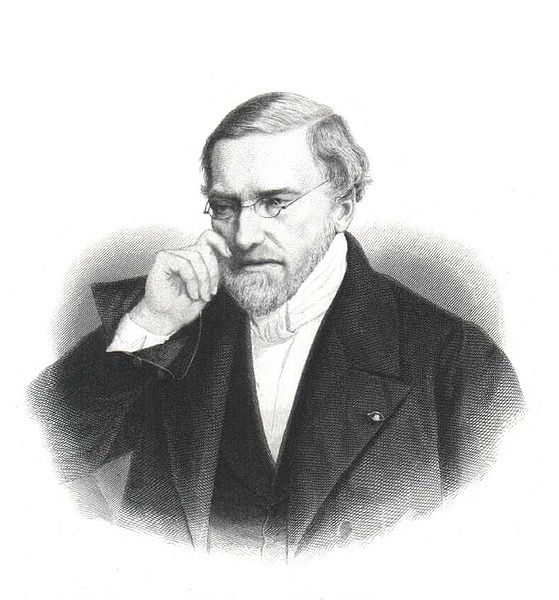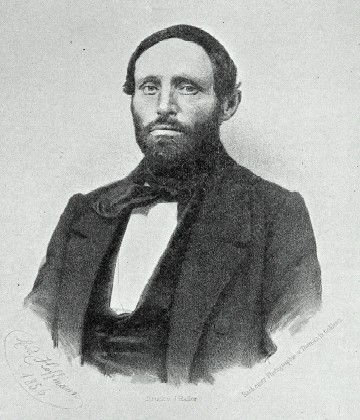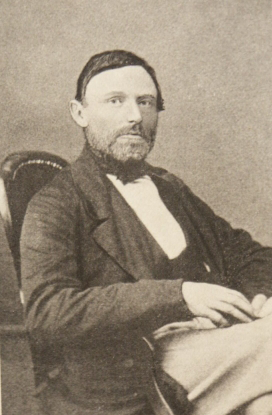<Back to Index>
- Mathematician and Engineer Jean - Victor Poncelet, 1788
- Chemist Karl Friedrich Mohr, 1806
PAGE SPONSOR

Jean - Victor Poncelet (July 1, 1788 – December 22, 1867) was a French engineer and mathematician who served most notably as the commandant general of the École Polytechnique. He is considered a reviver of projective geometry, and his work Traité des propriétés projectives des figures is considered the first definitive paper on the subject since Gérard Desargues' work on it in the 17th century. He later wrote an introduction to it; Applications d’analyse et de géométrie.
As a mathematician, his most notable work was in projective geometry, in particular, his work on Feuerbach's theorem. He also made discoveries about projective harmonic conjugates; among these were the poles and polar lines associated with conic sections. These discoveries led to the principle of duality, and also aided in the development of complex numbers and projective geometry.
As a military engineer, he served in Napoleon's campaign against the Russian Empire in 1812, in which he was captured and held prisoner until 1814. Later, he served as a professor of mechanics at the École d’Application in his home town of Metz, during which time he published Introduction à la mécanique industrielle, a work he is famous for, and improved the design of turbines and water wheels. After this, he served as professor at the Faculté des Sciences at the University of Paris, and finally as the commandant general of his alma mater, the École Polytechnique.
Poncelet was born in Metz, France, on July 1, 1788, the illegitimate son of Claude Poncelet, a lawyer of the Parliament of Metz and wealthy landowner. At a young age, he was sent to live with the Olier family at Saint - Avold. He returned to Metz for his secondary education, at the lycée. After this, he attended the École Polytechnique, a prestigious school in Paris, from 1808 to 1810, though he fell behind in his studies in his third year due to poor health. After graduation, he joined the Corps of Military Engineers. He attended the École d'Application in his hometown during this time, and achieved the rank of lieutenant in the French Army the same year he graduated.
Poncelet took part in Napoleon's invasion of Russia in 1812. His biographer Didion writes that he was part of the group that did not follow Marshal Michel Ney at the Battle of Krasnoi, which was forced to capitulate to the Russians, though other sources say that he was left for dead. Upon capture, he was interrogated by General Mikhail Andreyevich Miloradovich, but he did not disclose any information. The Russians held Poncelet as a prisoner of war and confined him at Saratov. During his imprisonment, in the years 1812 – 1814, he wrote his most notable work, Traité des propriétés projectives des figures, which outlined the foundations of projective geometry, as well as some new results. Poncelet, however, could not publish it until after his release in 1814.
In 1815, the year after his release, Poncelet was employed a military engineer at his hometown of Metz. In 1822, while at this position, he published Traité des propriétés projectives des figures. This work was the first major to discuss projective geometry since Desargues', though Gaspard Monge had written a few minor works about it previously. It is considered the founding work of modern projective geometry. Joseph Diaz Gergonne wrote about this branch of geometry at approximately the same time, beginning in 1810. Poncelet published several papers about the subject in Gergonne's mathematical journal Annales de Gergonne (officially known as Annales de mathématiques pures et appliquées).
In 1825, he became the professor of mechanics at the École d'Application in Metz, a position he held until 1835. During his tenure at this school, he improved the design of turbines and water wheels, deriving his work from the mechanics of the Provençal mill from southern France. Although the turbine of his design was not constructed until 1838, he envisioned such a design twelve years previous to that. In 1835, his left École d'Application, and in 1838 became a professor at the Faculté des Sciences in Paris with the support of François Arago.
In 1848, Poncelet became Commanding General of his alma mater; the École Polytechnique. He held the position until 1850, when he retired.
During this time, he wrote Applications d'analyse et de géométrie, which served as an introduction to his earlier work Traité des propriétés projectives des figures. It was published in two volumes in 1862 and 1864.
Poncelet discovered the following theorem in 1822: Euclidean compass and straightedge constructions can be carried out using only a straightedge if a single circle and its center is given. Swiss mathematician Jakob Steiner proved this theorem in 1833, leading to the name of the theorem. The constructions that this theorem states are possible are known as Steiner constructions.


Karl Friedrich Mohr (November 4, 1806 – September 28, 1879) was a German chemist famous for his early statement of the principle of the conservation of energy. Ammonium iron(II) sulfate, (NH4)2Fe(SO4)2.6H2O, is named Mohr's salt after him.
Mohr was born in 1806 into the family of a prosperous druggist in Koblenz. Being a delicate child, the young Mohr received much of his early education at home, a great part of it in his father's laboratory. This experience may be responsible for much of the skill Mohr later showed in devising instruments and methods of chemical analysis. At the age of twenty - one he began to study chemistry under Leopold Gmelin, and, after five years in Heidelberg, Berlin and Bonn, he returned with the degree of Ph.D. to join his father's establishment.
Mohr's father died during 1840 at which time Mohr assumed control of the family business. He retired from it for a life of scientific leisure in 1857, but at the age of fifty - seven some serious financial losses caused him to become a privatdozent in Bonn. In 1867 he was appointed, by the direct influence of the government, extraordinary professor of pharmacy.
Mohr was the leading scientific chemist of his time in Germany, and the inventor of many improvements in analytical methodology. He invented an improved burette which had a tip at the bottom and a clamp (a 'Mohr's clip'), which made it much easier to use than its predecessors, which were more similar to a graduated cylinder. His methods of volumetric analysis were expounded in his Lehrbuch der chemisch - analytischen Titrir - methode (1855) (Instructional Book of Titration Methods in Analytical Chemistry), which won special commendation from Liebig and ran to many editions. His Geschichie der Erde, eine Geologic auf neuer Grundlage (1866), was also widely circulated.
In a paper Über die Natur der Wärme (1837), Mohr gave one of the earliest general statements of the doctrine of the conservation of energy:
besides the 54 known chemical elements there is in the physical world one agent only, and this is called Kraft (energy). It may appear, according to circumstances, as motion, chemical affinity, cohesion, electricity, light and magnetism; and from any one of these forms it can be transformed into any of the others.